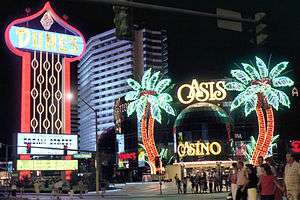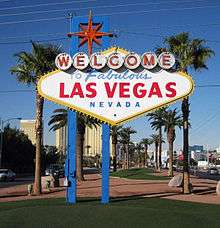Dunes (hotel and casino)
| Dunes Hotel and Casino | |
|---|---|
|
The Dunes Hotel and Oasis Casino in 1983, seen from Flamingo Road | |
 | |
| Location | Paradise, Nevada |
| Address | 3600 Las Vegas Boulevard South |
| Opening date | May 23, 1955 |
| Closing date | January 26, 1993 |
| Theme | Desert |
| Number of rooms | 1,300 |
| Signature attractions | Dunes Golf Course |
| Casino type | Land-based |
| Owner |
Masao Nangaku (1987–1992) Mirage Resorts (1992–1993) [1] |
| Architect | Maxwell Starkman |
| Renovated in |
1961 (tower) 1964 1971 1979 (tower) |
| Coordinates | 36°06′47″N 115°10′35″W / 36.11306°N 115.17639°WCoordinates: 36°06′47″N 115°10′35″W / 36.11306°N 115.17639°W |
The Dunes Hotel was a hotel and casino on the Las Vegas Strip in Paradise, Nevada, that operated from May 23, 1955 to January 26, 1993. Designed by architect Maxwell Starkman, it was the tenth resort to open on the Strip. Bellagio now stands on the former grounds. The Dunes golf course is now occupied by parts of Monte Carlo, New York-New York, CityCenter, and Cosmopolitan, and T-Mobile Arena.
History
Opening and early years (1955-1960s)
The Dunes opened on May 23, 1955, as a low-rise resort with Hollywood star Vera-Ellen providing the entertainment in the Magic Carpet Review.
On January 10, 1957, in a desperate move to keep the resort afloat, the Dunes became the first hotel/casino in Nevada to offer a topless show, called Minsky's Follies - the first of which was "Minsky Goes to Paris." The State Legislature was "in an uproar", but the show set a record for attendance in a single week at 16,000.
In 1961, a 24 story northern tower, called Diamond of the Dunes, was built, bringing the number of rooms up to 450. At the time, it was one of the finest and largest hotels on the Strip. The hotel was built in part with financing from movie mogul Al Gottesman and the Teamsters Pension Fund. The major investors were Joseph Sullivan, Alfred Gottesman and Bob Rice. (It was later believed that Raymond Patriarca, the head of a Providence, Rhode Island crime family was the source of Sullivan's investment.) It was designed by architect Maxwell Starkman.[2] The resort soon ran into financial difficulties and the casino closed after a year. The resort was purchased in 1956 by two businessmen, Major A. Riddle and Jake Gottlieb, who had dealings with the Chicago Outfit.[3] The resort boasted an 18-hole golf course, a rooftop health spa and a 90 ft (27 m) long pool. The Hotel's Slogan was "The Miracle in the Desert".[4]
In its early years, the Dunes was known for the 35 ft (11 m) tall fiberglass sultan (1964) that stood above its main entrance. Many top performers, such as Dean Martin, Jayne Mansfield, Liberace, George Burns, Pat Cooper, Judy Garland, Violetta Villas, Phyllis Diller and Frank Sinatra, performed at the hotel.
Operation (1960s-1980s)

Although it opened to much fanfare, it struggled from the start: one reason was its location at what was then the southernmost part of the Strip. The hotel frequently had to borrow money, and even the Sands Hotel lent its executives to help out, as well as bringing in numerous famous celebrities and entertainers such as Frank Sinatra's surprise appearance dressed as a sultan. In the late 1960s, Morris Shenker bought an interest in the Dunes and became its Chairman of the Board. In 1970, there were unrealized rumors Howard Hughes would buy into the hotel.
In The Showroom for 2 years, Johnny Elvis Foster starred in his Elvis show For The Love Of Elvis. Morris Shenker was Johnny Elvis Foster's godfather. Johnny was the first Elvis impersonator before Elvis died, on the strip, from 1976 to 1978 at the hotel.
In 1979, the South Tower was added, expanding the hotel to 1300 rooms.
Stuart and Clifford Perlman, founders of Caesars World, agreed to buy the Dunes in 1983 for $185 million, and even took over operation of the property for several months, but the sale ultimately fell through. A second casino in a separate, round building on the site opened in 1983 under the name Oasis Casino at The Dunes.[5] In 1984, Shenker filed for bankruptcy, and soon after, Major Riddle's company (M & R Investment Company) also filed bankruptcy, leading to the resort's sale. The sultan statue, by now on the golf course, caught fire in 1985, reportedly due to an electrical short. In 1987, Japanese investor Masao Nangaku purchased the Dunes "for $155 million but could not make it a financial success".[4]
Final years (1990-1993)
On November 17, 1992, the Dunes was sold for the last time to developer Steve Wynn's company, Mirage Resorts, Inc. for $75 million.[4][6]
Closing and demolition
On January 26, 1993, the Dunes closed its doors for good. A liquidation sale was conducted by National Content Liquidators to clear the property of its contents as a prelude to the building's demolition. Like many of the legendary properties of its era, it could no longer compete with the newer and more exciting megaresorts that were being built.
Steve Wynn bought the Dunes and started the redevelopment trend with the demolition of the 32-year-old North Tower. On October 27, 1993, the Dunes was demolished in a grand ceremony that involved major fireworks displays and the use of several "cannon blasts" from the English ship 'HMS Britannia' of Treasure Island Hotel and Casino. Over 200,000 people watched its demise. The Dunes sign itself was lit and read "No Vacancy" as if it were still open. Steve Wynn, along with Controlled Demolition, Inc. stood by and said "Captain of the Britannia, are you ready sir? Prepare broadside. Ready! Aim! Fire!" Cannon shots from the ship were simulated to coincide with explosions along the Dunes property. The neon sign was destroyed and a fireball fueled by 16,000 liters (4226 gallons) of aviation fuel engulfed the Diamond Tower shortly before explosives brought it down. Everything except the south tower was destroyed "amid a shower of fireworks never before equaled west of the Mississippi."[6]
The 15-year-old South Tower was demolished 9 months later in July 1994, with no fanfare and minimal media attention. The demolition also held symbolic significance for the city. Many long-time residents knew the Dunes was controlled by the mafia, having been first built with money from it and the mob-controlled pension funds of the Teamsters and Pipefitters unions. The demolition signaled the end of significant mafia control and influence in Las Vegas.
For many years, the hotel was owned by Major Riddle from the "Chicago Outfit" and later sold in part to Morris Shenker, an "attorney associated with the St. Louis Mafia, Meyer Lansky, Jimmy Hoffa, and Frank Foster, owner of Athony Alarm".[7] Riddle and Shenker later became a target of the Organized Crime Strike Force in St. Louis.[8]
During its construction of a new resort and casino, workers found four bags of Dunes casino chips that were buried at the site.[9]
The Bellagio now stands in its place. The Dunes golf course is now occupied by parts of Monte Carlo, New York-New York, CityCenter, and Cosmopolitan, and T-Mobile Arena.
Popular culture
- The Dunes makes a cameo in the video game Fallout: New Vegas under the name of "Gomorrah".
- The hotel was used in the intro of Vega$.
- The Dunes sign can be seen in the movie Diamonds Are Forever as James Bond rides in the back of the diamond smuggler's van to the research center.
- The Dunes can be seen extensively in the The Bionic Woman episode, "Fembots in Las Vegas".
- The Dunes sign can be seen and the hotel is featured in the Charlie's Angels episode "Angels in Vegas".
See also
References
- ↑ Las Vegas History - Dunes Hotel & Casino
- ↑ Dunes hotel tower architect Starkman dies, Las Vegas Sun, January 26, 2004
- ↑ The History of the Las Vegas Strip - Blog
- 1 2 3 Dunes/Bellagio
- ↑ Classic Las Vegas: The Dunes Hotel History
- 1 2 History of Las Vegas
- ↑ Las Vegas Casinos and Past Mob Ties
- ↑ Aladdin, A Casino With A Colorful Past, Rises Again
- ↑ Dunes Casino listing at 702dice.com
External links
| Wikimedia Commons has media related to Dunes (hotel and casino). |


